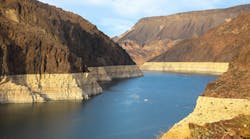Harvesting Rain for California's Public Transit
The construction of the Expo Rail Operations and Maintenance Facility in Santa Monica, Calif., for the Exposition Metro Line Construction Authority (Metro) meets operational demands for the region’s increased transportation needs, but creates impermeable surfaces requiring assertive storm water management approaches.
Landscape irrigation, vehicle washing and other water needs create an estimated 5,500 gal per day of water demand at the new operations and maintenance facility. Focusing on green building and energy efficiency, Metro officials sought a low-impact development design with zero storm water runoff. Poor soil conditions precluded soil infiltration to replenish aquifers. The best option was rainwater harvesting for non-potable uses, an increasingly popular solution for reducing reliance on municipal water.
The team providing the solution included Kiewit Building Group Inc., with W2 Design Inc. serving as the civil designer for the Maintenance Design Group, the facility’s lead designer.
Oldcastle Stormwater Solutions, a division of Oldcastle Precast Inc., assembled a team to provide the total storm water management system, including a 400,000-gal StormCapture cistern, upstream pretreatment and a storm water harvesting system from Water Harvesting Solutions (WAHASO). The solution provides across-the-board efficiencies in water use by reducing the impact on the municipal water supply, land footprint, system maintenance time and budgetary concerns.
“Oldcastle has a diverse portfolio of products that afforded the project economies of scale and the required 50-year design life,” said Patrick Wong, P.E., president of W2 Design.
The StormCapture system—occupying a small footprint under the parking lot due to large storage capacity per square foot of area—encompasses 29 StormCapture precast concrete modules measuring 12 ft inside height by 7 ft wide by 15 ft long. One module is deeper and houses an integrated pump station to supply water for the harvesting system.
Pretreated storm water flows into the StormCapture system’s concrete cistern modules, temporarily storing it for harvesting purposes. Water from the cistern flows into the concrete pump station module, which also serves as an internal overflow bypass should the cistern be filled to capacity during a rain event.
“We are able to capture all of the runoff in this one underground system, allowing [Metro] to keep its parking lot intact, provide the storage it needs and provide the sustainable benefits of harvesting water. In addition, the system was tested to confirm watertightness after installation,” said Jason Hermann, engineering manager for Oldcastle Precast.
The harvested water will be used for irrigation of landscaping and train washing. “California gets seasonal rains, but the cistern is large enough for us to harvest retained water over a period of months to maximize the system’s value,” said John Bauer, president of WAHASO.
WAHASO integrates OptiRTC technology into its storm water harvesting systems, which uses predictive modeling to actively determine storm water detention requirements and release stored water only as necessary to meet capacity requirements for each forthcoming storm event. OptiRTC monitors local weather forecasts to anticipate storm flows for detention within 24 hours of occurrence. It lowers cistern/retention storage levels ahead of the precipitation event and closes the outlet valve during storms to capture and retain water for harvesting.
“Without the OptiRTC capability of actively managing the cistern level, we would have been required to meter out all detained water over a short period of time, minimizing any real value of the harvesting system,” Bauer said.
The storm water management techniques utilized will contribute toward a LEED Gold rating for the facility and achieve Metro’s goals of water conservation, reuse and green building practices.
Download: Here


